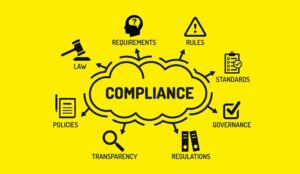Compliance is a pressing concern for call centres worldwide, with 61 percent of companies now allocating more money to their compliance budgets compared to previous years.
Given the risks associated with regulatory breaches and the evolving complexity of adherence requirements, this is no surprise. A violation could cost an organization millions in fines and significantly damage the brand, impacting future revenue and growth potential.
As technology has developed, many contact centres have implemented AI tools to streamline their compliance processes and protect their organizations from breaches. But is automation the answer we have all been waiting for, or is the technology still too limited to rely on?
What Is Call Centre Regulatory Compliance?
What constitutes regulatory compliance in a call centre will vary somewhat depending on the industry, location, and other factors. But generally speaking, the term refers to a set of rules that call centres must adhere to in order to protect customer data and other sensitive information.
Regulatory bodies set these guidelines, and some organizations may have their own internal directives depending on the scope of their operations and the kind of work they do. Not every single one is applicable to every call centre, but even those that aren’t relevant can set a precedent in terms of best practices.
Given the volume of data processed in a typical call centre, it’s imperative that the right systems are in place to secure this data and protect customers.
Why Is Strict Compliance Essential for Your Call Centre?
As noted, compliance rules are in place to safeguard sensitive information and protect customer data. Failure to do so can result in legal repercussions, hefty fines, and extensive brand damage. It’s no surprise that call centre leaders are investing in this area in 2023.
According to a recent IBM report, the average cost of a data breach in the United States is $9.44 million. Last year, financial services provider Morgan Stanley agreed to pay a $60 million legal settlement after a lawsuit concerning an alleged failure to protect the clients’ personally identifiable information.
Regulators are becoming much stricter with regard to adherence. And given some of the eye-watering figures above, it’s vital that call centres do everything possible to ensure compliance.
What Are the Biggest Compliance Challenges for Call Centres?
Call centres face a wide range of compliance challenges around behavior, transparency, and data security, with different rules and guidelines applied depending on location, industry, and more. Some of the main areas of concern include:
Call Recording/Monitoring
Obtaining customer consent prior to recording calls is extremely important for contact centres. Legislation such as the Dodd-Frank Act and the Sarbanes-Oxley Act highlights the importance of this process.
Customer Payment Processing
Call centre agents regularly take payments over the phone, so it’s essential that they abide by PCI regulations to protect customers from fraud.
Outbound Calling
The Do Not Call Registry, the Fair Debt Collection Practice Act, and other regulations are in place to protect consumers in relation to outbound calls. Agents must be educated in best practices and adhere to these rules.
Agent Adherence
As the main points of contact for customers, agents have a lot of responsibility for ensuring privacy and maintaining data security. With regulations evolving and expanding, contact leaders must deliver regular, appropriate call centre training.
Information Transfer
The transfer of private information is heavily regulated, and in most cases, explicit written consent is necessary for such transfers. Call centres must be wary of this, given the daily volume of sensitive data they handle.
How Can AI and Automation Help Address Those Challenges?
AI and automation tools can help address these compliance challenges by streamlining processes and giving contact centre leaders greater insight into their organizational adherence, saving time and money.
In fact, the aforementioned IBM report found that organizations with a fully deployed AI and automation program were able to identify and contain breaches faster, saving $3.05 million.
With technology, you can mitigate risk by expanding compliance coverage and proactively monitoring interactions, giving you an extra layer of security and greater peace of mind.
Below, we will examine some of the main uses of AI and automation for regulatory adherence.
Compliance Audit Trail
Maintaining a compliance audit trail is one of the best ways to mitigate risk and demonstrate your commitment to regulatory adherence. An audit trail provides evidence of your compliance measures for regulators and emphasizes the importance of adherence to agents.
Using QA tools like AI-assisted scorecards, you can consistently track agent adherence and best practices throughout your entire organization, with automatic risk mitigation rules built into your scorecards.
What’s more, you can have separate scorecards exclusively concerned with compliance monitoring. Then, should you be required to provide evidence to regulators at any point, you will have an accurate, detailed audit trail on record.
Ensuring Data Protection
According to IBM, 83 percent of companies will face a data breach at some point. For call centres, this means legal action, financial repercussions, and reputational damage.
Fortunately, there are steps you can take to limit this risk and minimize the cost of such a breach. Tools like recording software and scorecards will go a long way to improving security.
However, one of the best ways to minimize risk is to implement AI and automation. Using AI tools, you can set up critical fail notifications, instantly alerting contact centre leaders in the event of a breach, so they can take swift action to correct course and safeguard your organization.
Acquiring Consent
Many necessary processes within the call centre environment, such as call recording and data storage, require prior customer consent. In the United States, the Federal Trade Commission requires that both customers and agents are made aware of any call recording.
Agents can alert customers and acquire consent using automated tools like interactive voice response systems to make sure that they never forget to ask and risk sanctions as a result. You can also keep a record of all interactions, forming part of your compliance audit trail.
Tracking What Agents Say (and Don’t Say)
As the frontline of the contact centre, agents bear a great deal of responsibility when it comes to ensuring compliance. They deal with customers directly and must safeguard the data privacy of these customers.
To do this, many call centres are turning to automation and AI tools. Technology can track whether or not agents are adhering to scripts and send reminders to prevent agents from making costly blunders or letting standards slip.
With conversational analytics software, you can analyze your agent–customer interactions to identify compliance failures and receive automatic notifications in the event of such a failure. This allows for highly comprehensive monitoring.
Compliance Training
Delivering regular compliance training is essential for ensuring regulatory adherence in your organization. It’s not enough to do it once as part of the onboarding process; you need to keep your agents updated on the latest regulatory developments and best practices with ongoing coaching.
Policies are always evolving to keep up with new technologies, and agents are tasked with handling a lot of customer data, so you must support them with consistent, targeted training.
Using AI alongside scorecards, you can identify trending mistakes and risk areas and focus your training approach on these key concerns. You can also identify agents who perform best in compliance and incorporate their interactions as use cases in your training programs.
Redaction
When it comes to payment details, in particular, call centres need to be careful about how they mention this information. To protect customer data without losing access to essential details, you can implement AI tools capable of selective redaction.
This allows you to protect sensitive customer data without losing any important information necessary for evaluations or coaching. With this AI-driven approach, you have stronger security for customers and better data control for your call centre.
Is AI a Cure-All for Contact Centre Compliance?
While AI can drastically improve call centre compliance, it’s not a cure-all; some human supervision will always be required. Despite technological advances, artificial intelligence still isn’t capable of emulating the complexities of human judgment. An overreliance on AI insights could lead to misinformed business decisions.
The best approach is to view AI as a support tool for your agents, not a potential replacement. This will also benefit agent performance. If they view AI as an assistant rather than a threat, they will be more willing to incorporate the tools into their work.
Remember that regulations are always evolving, and you must update automations as these changes arrive. Updating workflows and processes to keep pace with changing laws requires human input.
Similarly, AI implementation will need human review from time to time after the initial setup. You need to review the impact of QA automations and make adjustments based on your insights. If needed, you can refine these processes to ensure they are serving your contact centre’s needs as efficiently as possible.
Finally, as with any new tool, implementing AI requires training to ensure everyone involved can use the new technology effectively. Anyone handling information throughout the organization will require ongoing training on how to use AI for regulatory compliance.
This blog post has been re-published by kind permission of Scorebuddy – View the Original Article
For more information about Scorebuddy - visit the Scorebuddy Website
Call Centre Helper is not responsible for the content of these guest blog posts. The opinions expressed in this article are those of the author, and do not necessarily reflect those of Call Centre Helper.
Author: Scorebuddy
Published On: 12th Jun 2023 - Last modified: 9th Dec 2024
Read more about - Guest Blogs, Scorebuddy






 Scorebuddy is quality assurance solution for scoring customer service calls, emails and web chat. It is a dedicated, stand-alone staff scoring system based in the cloud, requiring no integration.
Scorebuddy is quality assurance solution for scoring customer service calls, emails and web chat. It is a dedicated, stand-alone staff scoring system based in the cloud, requiring no integration. 









